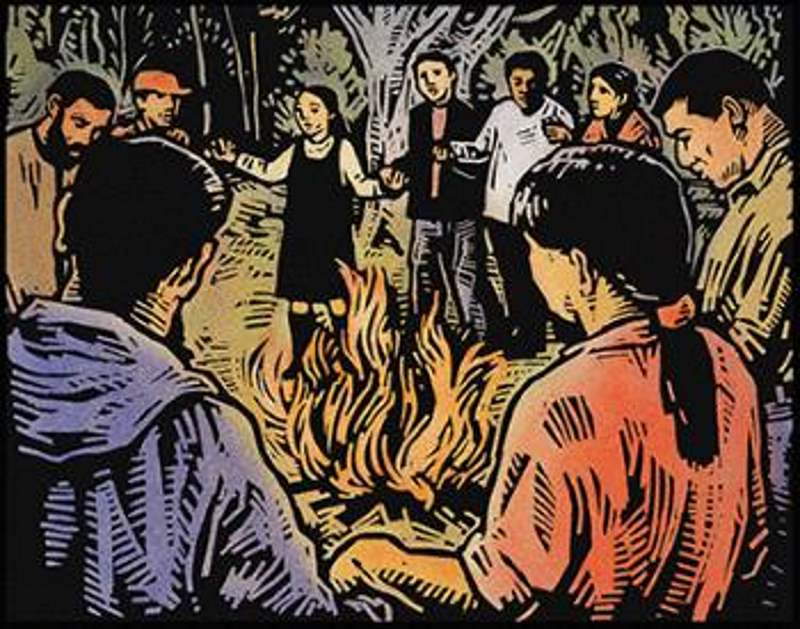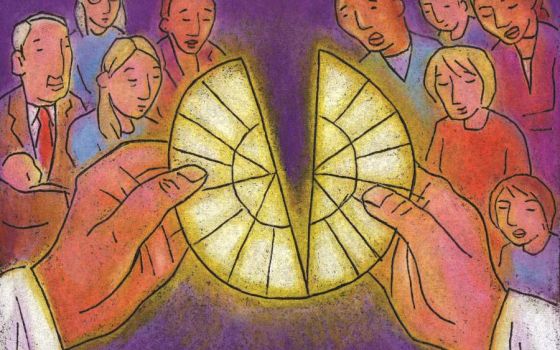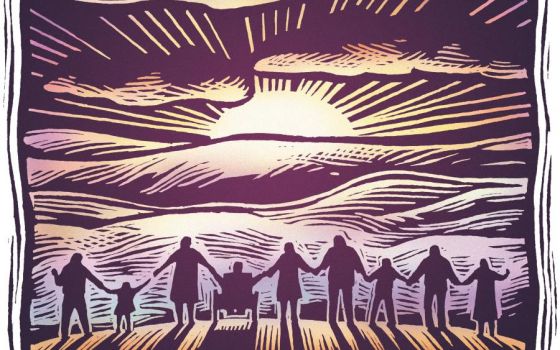
(Julie Lonneman)
June, for those of us who live in the Northern Hemisphere, is a time of flowers in full bloom, a time when the sun lingers for hours in the sky. A time of brides and grooms gazing into one another's eyes. Weddings punctuate almost every weekend on the calendar, mingled with family picnics in the park and early dips with the kids in the pool. It is a season for falling in love, a season for celebrating love.
The liturgical calendar offers us a number of beautiful feasts this June, each of which highlights a different dimension of the mystery of love as we have come to know it in our lives as Christians. Even as the end of the Easter season casts us into the green of Ordinary Time, these feasts keep our Sundays garbed in white three out of the four weeks of the month.
The Solemnity of the Most Holy Trinity
The first of the feasts this June is the Solemnity of the Most Holy Trinity, a feast always celebrated on the Sunday following Pentecost. It is considered one of the most difficult feasts to preach; homilists are often tempted simply to shrug and tell the congregation that the Trinity is a great mystery, and so no one should hope to really understand it.
The Trinity is a great mystery — indeed, the greatest mystery there is — but this does not mean that the Trinity is unknowable. Rather, our belief that God exists as "Three in One" emerged because God did reveal the divine self to us in the person of Jesus Christ. In Jesus' preaching and in his actions, most especially in his dying and in his rising, we came to recognize not simply that God is loving or that God is like love, but that God is love.
Now consider the nature of love for a moment as it surrounds us in this month of weddings and family gatherings. Of what does love consist? How does love function? At a very core level, we might say that the dynamic of love is twofold. When we love someone, we want to be with them. We want to be close to them. We want to be "one" with them — one heart, one mind, even one body. Clearly this drive for communion is most explicit in the sexual expression of married couples. And yet it has many manifestations.
An ancient Persian legend says that in the early days of creation, the first human parents loved their children so much that they ate them, and God was forced to reduce parental love by 99 percent so the human species could survive. Even today, many cultures around the world have specific words to describe the desire to nibble and squeeze little babies. We simply can't get close enough to those we love.
Love's desire for oneness, however, must be counterbalanced by the requirement of separateness. If we are so close that we become one, then there is no "other" any longer to love. Love is not love if its object is itself. The nature of love always requires that there be an other. How many romances do we know that have ended because one of the partners lost himself or herself in the relationship, and there was not enough differentiation to sustain the spark? The dynamic of love is one of inherent tension: the desire to be one while at the same time the need to remain an individual.
In our human relationships, we constantly struggle to strike a perfect balance between communion and differentiation, between unity and diversity. In our relationships, we give too much; we take too much. We lose too much; we withhold too much. But when we say that God is Trinity, we are saying that God dwells in this elusive balance. In God, there exists the dynamic of communion and differentiation in perfect harmony. In essence, God is right relationship.
The good news of Jesus Christ is that we are invited to share in that right relationship of God. God is not a spiraling romance up in the heavens. No, the romance that is God has swirled through the earth, wrapping us up into it. "God is love," asserts 1 John 4:16, "and those who abide in love abide in God and God abides in them." When we experience a taste of love, we are experiencing a taste of God. And when we experience an immersion in love — through a deep friendship or marriage or parenting — we are experiencing an immersion in God.
The Trinity is a mystery not because we can't understand God. We can and we have. The Trinity is a mystery because love is a mystery.
The celebration of Trinity Sunday is an occasion for each of us to bask in the relationships that give our life meaning and to recognize that wherever there is love between us, there is God. It is also an opportunity for us to challenge ourselves to grow spiritually by growing in our capacity for relationship, to learn the skills and practice the virtues that nurture family and friendship. Are we able to give of ourselves freely? Are we able to receive joyously? Can we appreciate difference? Can we learn to live as one?
Body and Blood of Christ
The Sunday immediately following Trinity Sunday marks another significant feast in the church's year: the Solemnity of the Most Holy Body and Blood of Christ. On one hand, this feast hardly seems necessary. Every Sunday is a celebration of Christ present with us in Eucharist. Yet the placement of the feast just after Trinity Sunday invites a focused reflection on how the two mysteries relate. If the doctrine of the Trinity is intended to initiate us into the dynamics of love, it is worth considering how Eucharist does the same.
Above, we considered how love creates within us a desire to be with one another, to be completely present to one another. Jesus' entire life bears witness to this desire. In his birth, we celebrate the mystery of the Incarnation, God's great desire to be with us and share in the human condition. Throughout his ministry, Jesus is with people — eating with them, listening to their pleas, healing them, in dialogue with them. In his death, Jesus enters into solidarity with us at the level of our deepest suffering and fear. In all things he wants to be with us.
The depth of Jesus' desire for communion with us became clear to me several years ago when I was reading the resurrection story with a group of small children. When I arrived at the angel's announcement of his rising, one 6-year-old said, "Well, of course!" "Why ‘of course'?" I asked. She replied, "The Good Shepherd loves his sheep so much, he can't stand to be away from them." I had long understood Jesus' death as an act of love; she helped me to see that his rising was also an act of love. A few weeks later, with the same group, I was introducing the theme of Eucharist. "Well, of course!" another child said. Puzzled, I again asked for clarification only to receive the same answer: "The Good Shepherd loves his sheep so much, he can't stand to be away from them."
There will come a time when we will see God face to face, but in the interim, Jesus' desire to be with us is so strong that he can't stay away; he has chosen to make his presence known in bread and wine. His desire to be one is so great that he makes of himself a meal to be consumed, food for the feast.
As we celebrate the Solemnity of the Most Holy Body and Blood of Christ, we are invited to ponder ever more deeply love's drive to be in communion. To what length are we willing to go to be in solidarity with others? What does it mean to be fully present to another? What keeps us from being able to be fully present? How do we increase our capacity to live in communion?
Advertisement
Birth of St John the Baptist
The long days of June will not depart without the celebration of another great feast: the Solemnity of the Nativity of St. John the Baptist on June 24. The feast falls on a Sunday this year, which constellates it in relation to Trinity Sunday and the Feast of the Body and Blood in a way that rarely happens in the liturgical calendar. The unique setting lends itself to ongoing reflection on the dynamics of love.
We celebrate John's birth exactly six months from the eve of Christmas. As the evangelist Luke reports, the angel Gabriel appeared to Mary "in the sixth month" of Elizabeth's pregnancy. Given the regular rhythms of human gestation, John and Jesus will always be separated by these six months. And, given the regular rhythms of the solar system, the celebration of their births will always fall in polar opposite seasons of the year. Jesus' birth will fall just after the winter solstice (for those us in the Northern Hemisphere), when the days, ever so subtly, will begin to lengthen: "The people who walked in darkness have seen a great light" (Isaiah 9:1). John's birth will fall just after the summer solstice, when the days, ever so subtly, will begin to shorten: "He must increase; I must decrease" (John 3:30). No two days in the year stand in starker contrast than the winter solstice and summer solstice, and perhaps no two personalities in the Gospels stand in starker contrast than Jesus and John. And yet, in their differentiation, they work in perfect harmony.
Once again we find ourselves pondering the mystery of love, which drives us toward communion with one another and at the same time illumines what is unique in each of us, brings out the differences among us. John preached in the desert; Jesus roamed in cities and towns. John fasted; Jesus ate and drank liberally. John baptized with water, Jesus with the Holy Spirit. Yet in the designs of God, they were intimately related to one another — cousins able to recognize each other while still in utero. They shared a common baptism; they shared a common mission. Each would not be who he was if the other did not exist. Jesus' ministry is launched by the ministry of John. John says Jesus came before him. Who can separate them from the love that is God?
As we mark the feast of John's birth again this year, we can pause to consider once more the relationships in our lives and ask: How have we experienced becoming more uniquely ourselves in the context of these relationships? In the daily dance that we do with each other, how do we know when it is time to "increase" and when it is time to "decrease"? How in our differences are we still one?
All around us, the world recognizes June as the month of love. May our liturgical celebrations this June nudge us toward a richer understanding of love and a fuller experience of the divine love that wants to permeate and perfect all our relationships.
Editor's note: This reflection was originally published in the June 2012 issue of Celebration. Sign up to receive daily Easter reflections.








